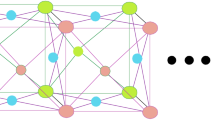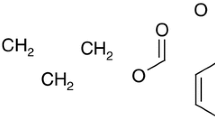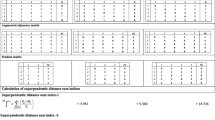Abstract
A genetic algorithm based multiple linear regressions (GA-MLR) method was applied for quantitative structure property relationship (QSPR) modeling of stability constants for 65 complexes of 1,4,7,10,13-pentaoxacyclopentadecane ethers (15C5) with sodium cation (Na+). The best subset of molecular descriptors was selected with genetic algorithm subset selection procedure, to a variety of theoretical molecular descriptors, calculated by the Dragon software. The MLR model was developed with particular attention to external validation and applicability domain (AD). The validation was performed on the internal and external validation sets. The QSPR model presented in this study showed most accurate predictions with the leave one out cross validated variance (\( {\text{Q}}_{\text{loo - cv}}^{2} \) = 0.88) and the external-validated variance (\( Q_{\rm ext}^{2} \) = 0.82). The AD of the models was analysed by the leverage approach.


Similar content being viewed by others
References
Saleh, M.I., Kusrini, E., Fun, H.K., Yamin, B.M.: Structural and selectivity of 18-crown-6 ligand in lanthanide–picrate complexes. J. Organomet. Chem. 693, 2561–2571 (2008)
Moriuchi-Kawakami, T., Aoki, R., Morita, K., Tsujioka, H., Fujimori, K., Shibutani, Y., Shono, T.: Conformational analysis of 12-crown-3 and sodium ion selectivity of electrodes based on bis(12-crown-3) derivatives with malonate spacers. Anal. Chim. Acta 480, 291–298 (2003)
Takeda, Y., Yasui, A., Katsuta, S.: Extraction of sodium and potassium perchlorates with dibenzo-18-crown-6 into various organic solvents. Quantitative elucidation of anion effects on the extraction-ability and -selectivity. J. Incl. Phenom. Macrocycl. Chem. 50, 157–164 (2004)
Kim, H.S., Chi, K.W.: Monte Carlo simulation study for QSPR of solvent effect on the selectivity of 18-crown-6 between Gd3+ and Yb3+ ions. J. Mol. Struct. Theochem. 722, 1–7 (2005)
Kim, H.S.: QSPR analysis of solvent effect on selectivity of 18-crown-6 between Nd3+ and Eu3+ ions: a Monte Carlo simulation study. Bull. Korean Chem. Soc. 27, 2011–2018 (2006)
Kim, H.S.: QSPR analysis of solvent effect on selectivity of 18-crown-6 between Nd3+ and Eu3+ ions: a Monte Carlo simulation study. Abstr. Pap. Am. Chem. Soc. 230, U1327–U1328 (2005)
Yazdi, A.S., Mofazzeli, F., Es’haghi, Z.: Determination of 3-nitroaniline in water samples by directly suspended droplet three-phase liquid-phase microextraction using 18-crown-6 ether and high-performance liquid chromatography. J. Chromatogr. A 1216, 5086–5091 (2009)
Parat, C., Betelu, S., Authier, L., Potin-Gautier, M.: Determination of labile trace metals with screen-printed electrode modified by a crown-ether based membrane. Anal. Chim. Acta 573, 14–19 (2006)
Raut, D.R., Mohapatra, P.K., Ansari, S.A., Sarkar, A., Manchanda, V.K.: Selective transport of radio-cesium by supported liquid membranes containing calix[4]crown-6 ligands as the mobile carrier. Desalination 232, 262–271 (2008)
Heng, L.Y., Hall, E.A.H.: Assessing a photocured self-plasticised acrylic membrane recipe for Na+ and K+ ion selective electrodes. Anal. Chim. Acta 443, 25–40 (2001)
Han, W.S., Lee, Y.H., Jung, K.J., Ly, S.Y., Hong, T.K., Kim, M.H.: Potassium ion-selective polyaniline solid-contact electrodes based on 4′,4″(5″)-di-tert-butyldibenzo-18-crown-6-ether ionophore. J. Anal. Chem. 63, 987–993 (2008)
Zeng, X.S., Han, X.X., Chen, L.X., Li, Q.S., Xu, F.B., He, X.W., Zhang, Z.Z.: The first synthesis of a calix[4](diseleno)crown ether as a sensor for ion-selective electrodes. Tetrahedron Lett. 43, 131–134 (2002)
Pozzi, G., Quici, S., Fish, R.H.: Perfluorocarbon soluble crown ethers as phase transfer catalysts. Adv. Synth. Catal. 350, 2425–2436 (2008)
Xia, L.X., Jia, Y., Tong, S.R., Wang, J., Han, G.X.: Interfacial behavior of phase transfer catalysis of the reaction between potassium thiocyanate and p-nitrobenzyl bromide with crown ethers as catalysts. Kinet. Catal. 51, 69–74 (2010)
Jaszay, Z., Pham, T.S., Nemeth, G., Bako, P., Petnehazy, I., Toke, L.: Asymmetric synthesis of substituted alpha-amino phosphonates with chiral crown ethers as catalysts. Synlett. 9, 1429–1432 (2009)
Seki, A., Motoya, K., Watanabe, S., Kubo, I.: Novel sensors for potassium, calcium and magnesium ions based on a silicon transducer as a light-addressable potentiometric sensor. Anal. Chim. Acta 382, 131–136 (1999)
Katritzky, A.R., Chen, K., Maran, U., Carlson, D.A.: QSPR correlation and predictions of GC retention indexes for methyl-branched hydrocarbons produced by insects. Anal. Chem. 72, 101–109 (2000)
Ghasemi, J.B., Ahmadi, S., Brown, S.D.: A quantitative structure-retention relationship study for prediction of chromatographic relative retention time of chlorinated monoterpenes. Environ. Chem. Lett. (2009) (in press)
Fang, L., Huang, J., Yu, G., Li, X.: Quantitative structure-property relationship studies for direct photolysis rate constants and quantum yields of polybrominated diphenyl ethers in hexane and methanol. Ecotoxicol. Environ. Saf. 72, 1587–1593 (2009)
Ghasemi, J., Ahmadi, S.: Combination of genetic algorithm and partial least squares for cloud point prediction of nonionic surfactants from molecular structures. Ann. Chim. Rome 97, 69–83 (2007)
Tetko, I.V., Solov’ev, V.P., Antonov, A.V., Yao, X., Doucet, J.P., Fan, B., Hoonakker, F., Fourches, D., Jost, P., Lachiche, N., Varnek, A.: Benchmarking of linear and nonlinear approaches for quantitative structure–property relationship studies of metal complexation with ionophores. J. Chem. Inf. Model. 46, 808–819 (2006)
Yao, X.J., Fan, B.T., Doucet, J.P., Panaye, A., Liu, M.C., Zhang, R.S., Zhang, X.Y., Hu, Z.D.: Quantitative structure property relationship models for the prediction of liquid heat capacity. QSAR Comb. Sci. 22, 29–48 (2003)
Gakh, A.A., Sumpter, B.G., Noid, D.W., Sachleben, R.A., Moyer, B.A.: Prediction of complexation properties of crown ethers using computational neural networks. J. Incl. Phenom. Mol. Recognit. Chem. 27, 201–213 (1997)
Shi, Z.G., Mccullough, E.A.: A computer simulation statistical procedure for predicting complexation equilibrium constants. J. Incl. Phenom. Mol. Recognit. Chem. 18, 9–26 (1994)
Varnek, A., Wipff, G., Solov’ev, V.P., Solotnov, A.F.: Assessment of the macrocyclic effect for the complexation of crown-ethers with alkali cations using the substructural molecular fragments method. J. Chem. Inf. Comput. Sci. 42, 812–829 (2002)
Ghasemi, J., Saaidpour, S.: QSPR modeling of stability constants of diverse 15-crown-5 ethers complexes using best multiple linear regression. J. Incl. Phenom. Macrocycl. Chem. 60, 339–351 (2008)
Leardi, R., Boggia, R., Terrile, M.: Genetic algorithms as a strategy for feature-selection. J. Chemom. 6, 267–281 (1992)
Todeschini, R., Consonni, V., Mauri, A., Pavan, M.: Detecting “bad” regression models: multicriteria fitness functions in regression analysis. Anal. Chim. Acta 515, 199–208 (2004)
Izatt, R.M., Pawlak, K., Bradshaw, J.S., Bruening, R.L.: Thermodynamic and kinetic data for macrocycle interaction with cations and anions. Chem. Rev. 91, 1721–2085 (1991)
Hyperchem, v.7.5. Hypercube Inc. http://www.hyper.com (2002)
Dewar, M.J.S., Zoebisch, E.G., Healy, E.F., Stewart, J.J.P.: AM1—a new general purpose quantum mechanical molecular model. J. Am. Chem. Soc. 107, 3902–3909 (1985)
Stewart, J.J.P.: Mopac 6.0, Quantum chemical program exchange. (1990)
Talete, S.: Dragon for windows (software for molecular descriptor calculations), version 5.4. http://www.talete.mi.it (2006)
Goldberg, D.E.: Genetic Algorithms in Search, Optimization, and Machine Learning. Addison-Wesley, Reading, MA (1989)
Goodarzi, M., Freitas, M.P., Wu, C.H., Duchowicz, P.R.: pKa modeling and prediction of a series of pH indicators through genetic algorithm-least square support vector regression. Chemom. Intell. Lab. 101, 102–109 (2010)
Cho, S.J., Hermsmeier, M.A.: Genetic algorithm guided selection: variable selection and subset selection. J. Chem. Inf. Comput. Sci. 42, 927–936 (2002)
Gharagheizi, F., Alamdari, R.F.: Prediction of flash point temperature of pure components using a Quantitative Structure–Property Relationship model. QSAR Comb. Sci. 27, 679–683 (2008)
Rogers, D., Hopfinger, A.J.: Application of genetic function approximation to quantitative structure–activity relationships and quantitative structure–property relationships. J. Chem. Inf. Comput. Sci. 34, 854–866 (1994)
Hemmateenejad, B., Miri, R., Akhond, M., Shamsipur, M.: QSAR study of the calcium channel antagonist activity of some recently synthesized dihydropyridine derivatives. An application of genetic algorithm for variable selection in MLR and PLS methods. Chemom. Intell. Lab. 64, 91–99 (2002)
Depczynski, U., Frost, V.J., Molt, K.: Genetic algorithms applied to the selection of factors in principal component regression. Anal. Chim. Acta 420, 217–227 (2000)
Jouanrimbaud, D., Massart, D.L., Leardi, R., Denoord, O.E.: Genetic algorithms as a tool for wavelength selection in multivariate calibration. Anal. Chem. 67, 4295–4301 (1995)
Atkinson, A.C.: Plots, Transformations and Regression. Clarendon Press, Oxford (1985)
Gramatica, P.: Principles of QSAR models validation: internal and external. QSAR Comb. Sci. 26, 694–701 (2007)
Guha, R., Serra, J.R., Jurs, P.C.: Generation of QSAR sets with a self-organizing map. J. Mol. Graph. Model. 23, 1–14 (2004)
Jaiswal, M., Khadikar, P.V., Scozzafava, A., Supuran, C.T.: Carbonic anhydrase inhibitors: the first QSAR study on inhibition of tumor-associated isoenzyme IX with aromatic and heterocyclic sulfonamides. Bioorg. Med. Chem. Lett. 14, 3283–3290 (2004)
Shapiro, S., Guggenheim, B.: Inhibition of oral bacteria by phenolic compounds—Part 1. QSAR analysis using molecular connectivity. Quant. Struct. Act. Relatsh. 17, 327–337 (1998)
Geary, R.C.: The contiguity ratio and statistical mapping. Incorp. Statist. 5, 115–145 (1954)
Consonni, V., Todeschini, R., Pavan, M.: Structure/response correlations and similarity/diversity analysis by GETAWAY descriptors. 1. Theory of the novel 3D molecular descriptors. J. Chem. Inf. Comput. Sci. 42, 682–692 (2002)
Consonni, V., Todeschini, R., Pavan, M., Gramatica, P.: Structure/response correlations and similarity/diversity analysis by GETAWAY descriptors. 2. Application of the novel 3D molecular descriptors to QSAR/QSPR studies. J. Chem. Inf. Comput. Sci. 42, 693–705 (2002)
Deswal, S., Roy, N.: Quantitative structure activity relationship studies of aryl heterocycle-based thrombin inhibitors. Eur. J. Med. Chem. 41, 1339–1346 (2006)
Acknowledgments
This work is supported by Islamic Azad University, Kermanshah Branch, Kermanshah, Iran.
Author information
Authors and Affiliations
Corresponding author
Rights and permissions
About this article
Cite this article
Ahmadi, S. Application of GA-MLR method in QSPR modeling of stability constants of diverse 15-crown-5 complexes with sodium cation. J Incl Phenom Macrocycl Chem 74, 57–66 (2012). https://doi.org/10.1007/s10847-010-9881-6
Received:
Accepted:
Published:
Issue Date:
DOI: https://doi.org/10.1007/s10847-010-9881-6




